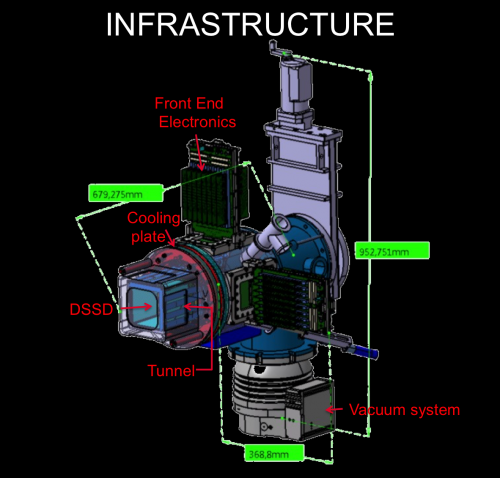The high-intensity stable beams of the superconducting linear accelerator of the SPIRAL2 facility at GANIL coupled with the Super Separator Spectrometer (S3) and a high-performance focal-plane spectrometer will open new horizons for the research in the domains of rare nuclei and low cross-section phenomena at the limit of nuclear stability. The research of these radioactive nuclei has been identified as one of the major subject which can be exploited by the stable beam part of the facility with the high heavy-ion beam intensities offered by its linear driver accelerator LINAC. Notably, superheavy and neutron deficient nuclei can be produced by fusion-evaporation reactions and selected by S3.
In order to study them, we need to perform the measurement of their decays (emission of proton, alpha, electron, and gamma).
The objective of the SIRIUS (Spectroscopy and Identification of Rare Isotopes Using S3) project is to develop, commission and exploit a state-of-art focal plane detector system for decay spectroscopy at the S3 separator. The focal plane system will be a complex device composed of a succession of detectors in a compact geometry using new advanced technologies. It will be capable of detecting heavy ions and subsequent decays with energy and time resolutions that allows clean identification of the rarest events. To achieve this objective SIRIUS will be composed of highly segmented double-sided silicon strip detectors (DSSD) to detect the implantation of the produced nuclei as well as their decay. The DSSD will be surrounded by a Tunnel detector composed of silicon pad detectors, this to measure charged particles (alpha, electrons and protons) escaping from the implantation silicon detector following the decay of the implanted ion. Germanium detectors in a close geometry around the implantation detector will be used for gamma decay spectroscopy. One or two emissive foil detectors will allow time of flight measurement and ion tracking. To respond to quite severe specifications demanded by the physics program new technologies have to be developed. A strong novelty in the SIRIUS project has been the development of new kinds of charge sensitive amplifier (CSA), which allows the complete energy range measurement with good energy resolution and extremely short dead time. The development of theses technologies has already successfully started within the SIRIUS community.
In summary, SIRIUS will combine the best performances of the existing detection set-ups:
- 20keV energy resolution (FWHM) for alpha particles, 5 keV for electrons,
- A high granularity with 700 µm strips in horizontal and vertical direction (256 channels with energy and time measurements),
- A time resolution better than 1ns,
- Counting rates of 10kHz with very low dead time and a triggerless data acquisition
As well, it has several very innovative characteristics:
- Trajectory reconstruction of very heavy/slow ions with 1mm resolution, to benefit from the mass resolution of S3,
- Large-size active area silicon detectors (100x100 mm2) for maximum efficiency,
- Windowless silicon detectors for low threshold detection and high-energy resolution of escape,
alpha-particles and electrons detected in the Tunnel detectors,
- Low dead time electronics to detect fast decays,
- Full digitalization of the signals to perform Pulse Shape Analysis,
- Ceramics support to enhance detector cooling, while maintaining a gamma-ray transparent geometry.
References:
F. Dechery et al., NIM 376 (2016) 125.
J. Piot and the S3 collaboration, Acta Physica Polonica B 43 (2012) 285.
Contact : Barbara Sulignano, DPhN, LENA.
• Structure of nuclear matter › Atomic nucleus
• Institut de recherche sur les lois fondamentales de l'Univers (Irfu) • Le Département d'Électronique des Détecteurs et d'Informatique pour la Physique (DEDIP) • The Nuclear Physics Division
• Système temps réel, électronique d'acquisition et microélectronique (STREAM) • LENA group - Structure of the Atomic Nuclei





